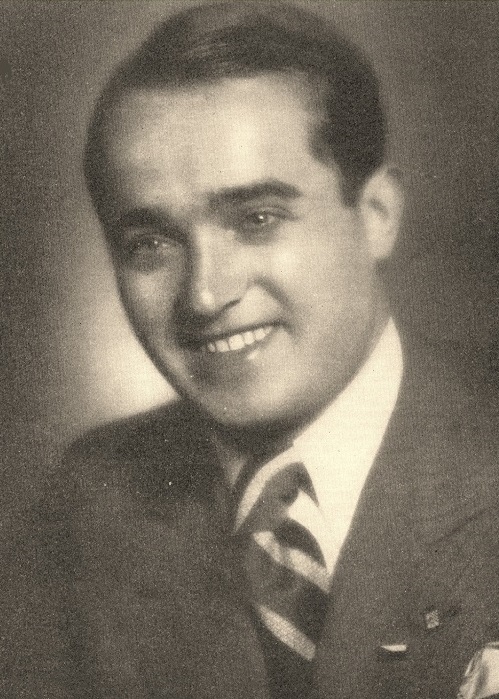
Edward Winter

An extract from C.N. 548, written in 1983:
The recent death of Salo Flohr, aged 74, removes from the chess world one of the finest players of the century. By the late 1930s he was in line for a world championship match with Alekhine, and was nominated (albeit unjustly, in our view) by FIDE as the official challenger. The match, however, never came about ... By the end of the Second World War, Flohr was but a shadow of his former self ...
Flohr was unquestionably at his best in the 1930s. Indeed – although this may not have been pointed out before – at Nottingham, 1936 he became the only player who has ever managed to beat both Lasker and Capablanca in the same tournament.
We gave as an illustration of Flohr’s play his victory over Mieses in the Bournemouth tournament, August 1939, with some brief text from the October 1939 BCM.
A pointless tale, often repeated (e.g. Chernev’s The Bright Side of Chess, page 19), is that at Nottingham, 1936 Salo Flohr thought he would win all the prizes because he heard the lift operator say ‘First Flohr, Second Flohr, Third Flohr’.
Before the story is printed yet again, it would be as well to mention that it had already been given in CHESS for 14 November 1935 (page 115), where the witticism is credited to Lilienthal. Since the writer of the article in question is George Koltanowski, one must be doubly sceptical.
(887)
‘Everywhere, it seems, adventure and anecdote awaited me’, Koltanowski writes on page 37 of Adventures of a Chess Master, neglecting to add that some of the anecdotes lurked in contradictory forms. An example is the ‘First Flohr’ yarn reported by him in a CHESS article (see C.N. 887) as having been told to him by Lilienthal. But on page 45 of his book With the Chess Masters (Falcon Publishers, 1972) he relates that Flohr himself was the speaker.
(1234)
From the introduction to W.H. Watts’ mid-twenties book Chess Masterpieces:
‘There is no possible doubt that the most popular chess books of the past have been collections of master games. ... Many chess books have proved unacceptable to the chessplaying public but not one collection of master games has been a failure.’
How times have changed. Nowadays one has to rely more and more on private companies or individuals for such annotated games collections. In a sane world Batsford or Pergamon would have snapped up Jimmy Adams’ new book Salo Flohr: Master of Tactics Master of Technique. Instead, it is to the Chess Player, Nottingham that we must be grateful for this finely-researched and well-produced volume.
The politician’s golden rule is never to criticize the electorate. Nonetheless, it is difficult to avoid the conclusion that the chess public is not blameless as regards current problems in the literature of our game. Too often it tends to misjudge the respective value of, for instance, a book on Alekhine and one on Alekhine’s Defence. It is interesting to speculate on whether the public would buy other kinds of works if fewer openings books were available.
For now there is a vicious circle. The small publisher can rarely aspire to the same production standards as the major companies. Nor can he afford a massive publicity campaign or large-scale despatch of review copies. Without the economies of scale his retail prices may have to be relatively high. All these factors, and others, help to keep the market for such works as the Flohr one far smaller than it deserves to be. We appreciate that it sounds patronizing to speak in terms of ‘educating the public’, but is not such education desperately needed?
Adams’ book has received only modest critical attention. At least it secured extensive publicity in Leonard Barden’s Financial Times column of 22 June [1985]. One matter of detail, however. We were puzzled by Mr Barden’s comment that Flohr’s position as FIDE’s official challenger ‘was ridiculed when he lost to two inexperienced British masters at Nottingham and finished bottom at AVRO’, and mentioned to him that Flohr did not become official challenger until 1937, the year after the Nottingham tournament. L.B.’s reply:
‘As so often in newspaper journalism, spelling everything out precisely requires far more space than one has. I think this point applies generally to some of your comments. I seem to remember that some critiques made before AVRO of FIDE’s 1937 decision referred back to Flohr’s Nottingham results and his losses to Alexander and Tylor.’
Mr Barden will forgive us, we hope, but why is imprecision any more tolerable in a newspaper than anywhere else? If the sentence in question had simply read ‘... was ridiculed when he finished bottom at AVRO’ (with no reference to Nottingham) it would not only have been more accurate; it would actually have saved space.
(1026)
Salo Flohr’s Best Games of Chess by Gregory S. Donges (Thinkers’ Press) is smartly produced despite a front-cover picture of Flohr aged about eight drawn by someone probably little older. Proof-reading of the introductory material is not impressive and the concluding tournament results list suffers from ignoring C.N. 596. No particular compliment comes to mind for the game annotations. Donges gives 50 games, as against 100 offered in the earlier Adams work [see C.N. 1026 above]. Moreover, Adams analysed in vastly greater detail. The only possible conclusion from all these considerations is not that Donges’ book is bad, but simply that it is unnecessary.
(1160)
Bled 1931 by Hans Kmoch translated by Jimmy Adams (Caissa Editions) starts with a highly interesting 12-page article (1976 vintage) on the tournament by Flohr. (If we are reading page xvi correctly, Flohr states that he was defeated by Alekhine in a simultaneous exhibition as early as 1925.)
(1491)
See too page 307 of Kings, Commoners and Knaves, where we quoted the English translation:
‘The first time I saw him was in 1925 (I first lost to him in an exhibition) ...’
In C.N. 8351 Steve Wrinn (Homer, NY, USA) mentioned regarding the Bled tournament book (Yorklyn, 1987) that the full above-mentioned Flohr article was reprinted on pages 26-30 of the March 2003 CHESS.
(8351)
We note that CHESS gave the same translation regarding the Alekhine passage, whereas in the 1976 64 article (pages 8-10 of the 27 February-4 March issue and pages 6-7 of the 5-11 March issue) Flohr’s comment in brackets stated that he was the first to lose against Alekhine in the 1925 display (‘Впервые я увидел его в 1925 году (я первым проиграл в сеансе ...’).
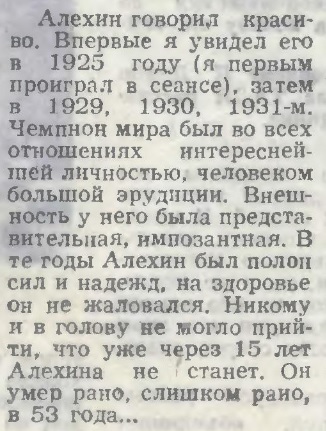
See too page 30 of Flohr’s memoirs Сквозь призму полувека (Moscow, 1986).
From page 48 of Evans on Chess by Larry Evans:
‘The “lapsus manus” variation derives its name from a slip of the hand made by world champion Alexander Alekhine in defense of his title.
Alekhine v Euwe, 5th match game 1935: 1 e4 e6 2 d4 d5 3 Nc3 Bb4 4 Ne2!? dxe4. Alekhine unintentionally moved his knight, sacrificing a pawn; but it turned out to be playable after 5 a3, and a new line was born.’
In fact, the ‘new line’ was already familiar, not to say famous. Alekhine played 4 Ne2 in his celebrated miniature against Nimzowitsch at Bled, 1931 – see page 94 of the second volume of his best games. There is no reason to believe it was a slip of the hand on either occasion.
Mr Evans is no doubt thinking of 1 e4 e6 2 d4 d5 3 Nc3 Bb4 4 Bd2 (Alekhine-Flohr, Nottingham, 1936), which Alekhine admitted, on page 17 of the tournament book, was a ‘lapsus manus’.
(1598)
From Photographs of Nottingham, 1936:
Alekhine in the first round (his lapsus manus opening against Flohr):
That picture is relatively well known, having been published, for instance, on page 16 of Chess Review, April 1946 and in The Treasury of Chess Lore by Fred Reinfeld (New York, 1951).
Alekhine’s note to 4 Bd2 in the tournament book:
‘A “lapsus manus”. I intended to play 4 P-K5 and P-B4, as, for instance, against Nimzowitsch at San Remo, 1930, but instead I made the move with the bishop first.’
From page 391 of Kings, Commoners and Knaves:
In La Nación in 1930 Alekhine described Flohr as ‘the second true talent to have emerged in the chess world since the War (the first was the Mexican Torre)’. The world champion also predicted ‘an exceptional chess future’ for Flohr.
Source: El Ajedrez Americano, August 1930, page 227.
‘It is fairly safe to prognosticate that for the next five years at least, Alekhine will be able to retain his title.’
Euwe in the Nieuwe Rotterdamsche Courant, an article reproduced on pages 150-153 of The Chess World, 1 January 1933.
In the same issue (pages 174-175) Alekhine was interviewed. Asked whether he thought that anybody could beat him, he replied:
‘No, I don’t think so. I have beaten them all, although I only beat Capablanca by a small margin. I just want to hold my own against my own generation. If one of the younger generation came along and beat me – well ... I don’t care.’
An instructive piece of endgame play:
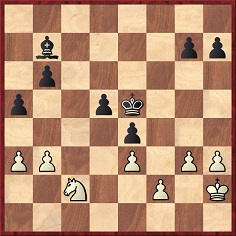
V. Pirc-S. Flohr, Rogaska Slatina, 1929
40...a4! 41 b4 d4!! 42 Nxd4 Kd5 43 Kg2 Ba6 44 f3 Kc4! 45 fxe4 Kc3 46 Nf5 Kb3 47 Nd6 Bd3! 48 e5 Bg6 49 h4 Kxa3 50 Kf3 Kxb4 51 Kg4 a3 52 h5 Bxh5+ 53 Kxh5 a2 54 White resigns.
Punctuation by Flohr, who presented this ending on page 189 of the December 1929 Československý Šach. It was also annotated, under the title ‘a Flohr masterpiece’, by Roberto Grau on pages 38-39 of the February 1940 El Ajedrez Americano. Since the whole game appeared on pages 73-78 of the Rogaska Slatina, 1929 tournament book, it may be wondered why such an interesting piece of play has been so neglected.
(2161)
From Copying:
When we were a contributor to the Chess Café website, at the time it was owned by Hanon Russell, he tried to combat misappropriation of our scans by adding a coloured diagonal band on them. A number of individuals simply reproduced the photographs with the band. An example is Helmut Wieteck in his book Salo Flohr und das Schachleben in der Tschechoslowakei. See the front cover, the title page and about a dozen more pictures in the body of the book.
Two Sicilian miniatures played early in Salo Flohr’s career:
Salo Flohr – Gottlieb Machate
Sumperk (Mährisch-Schönberg), August 1928
Sicilian Defence
1 e4 c5 2 Nc3 d6 3 Nge2 g6 4 d4 cxd4 5 Nxd4 Bg7 6 Be2 Nf6 7 O-O O-O 8 Be3 b6 9 f4 Bb7 10 Bf3 Nbd7 11 Re1 a6 12 Bf2 b5 13 e5 Bxf3 14 Qxf3 dxe5 15 fxe5 Nh5 16 Nc6 Qc7 17 Nd5 Qb7
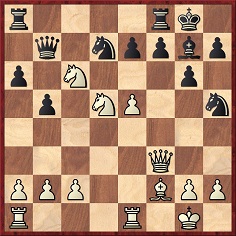
18 Nd8 Nxe5 19 Rxe5 Bxe5 20 Nxb7 Resigns.
Source: Deutsche Schachzeitung, October 1928, page 313.
Salo Flohr – Savielly Tartakower
Berlin, 1928
Sicilian Defence
1 e4 c5 2 Nf3 Nf6 3 d3 d5 4 Nbd2 Nc6 5 Be2 Bg4 6 h3 Bh5 7 e5 Nd7 8 e6 fxe6 9 Ng5 Bf7 10 Bg4 Nde5 11 Nxf7 Kxf7 12 Nf3 h6 13 Qe2 Nxg4 14 hxg4 Nd4 15 Nxd4 cxd4
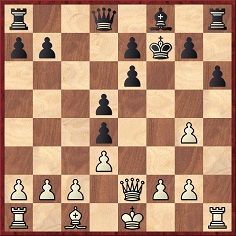
16 g5 Qd6 17 gxh6 gxh6 18 Qh5+ Kg8 19 Qg4+ Kh7 20 Bf4 Rg8 21 Qxg8+ and wins.
Our source for the above game is page 97 of Schachjahrbuch 1928 by L. Bachmann (Ansbach, 1929), which reported that this victory was from a series of ‘free games’ in which Flohr defeated Tartakower +6 –2 =5.
Page 176 of the November 1928 Československý Šach reported that in Berlin Flohr played various masters in ‘free games’ and participated in two rapid-play tournaments alongside such figures as Tartakower, Nimzowitsch and Spielmann.
(2565)
W.D. Rubinstein (Aberystwyth, Wales) refers us to an autobiography published in 2002, Interesting Times: A Twentieth-Century Life by Eric Hobsbawm.
‘Hobsbawm is a central European Jew who was, however, a British citizen at birth as his father had acquired British citizenship. He came to Britain in 1933 not as a refugee but as a result of his parents’ deaths, to live with relatives here. His first stop was a guest-house in Folkestone, which was inhabited chiefly by Jewish refugees. Hobsbawm, who was born in 1917, was 16 or so at the time. On page 79 of his book he states that among the guests staying there was:
“A grey figure from Carpathian Europe, one Salo Flohr, stranded by Alekhine’s refusal to accept his challenge for the world chess title [who] played chess with Uncle Sidney, while waiting to travel to Moscow to confront the Soviets’ Mikhail Botvinnik. Flohr never made it to the top, but was to become a well-known figure in the Soviet chess world, one of the few people for whom emigration to Stalin’s Russia in the 1930s was not a disaster.”
Hobsbawm, whom I know well and who is probably the greatest living historian, is writing about an ephemeral meeting nearly 70 years ago. Are his memories accurate?’
Flohr participated in the Folkestone Olympiad in June 1933. After tournaments in the Netherlands and Czechoslovakia he played a (drawn) match against Botvinnik in Moscow and Leningrad from 28 November to 19 December 1933 (see Reinfeld’s 1935 monograph on the contest). It remains to be established what dealings Flohr may have had with Alekhine at around this time.
(2769)
Avital Pilpel (Ramat Hasharon, Israel) draws our attention to the Hebrew book Shachmet Le’hana’atcha by Eliyahu Fasher (second edition, Kibutz Kabri, 1980). Pages 168-171 discuss Flohr’s visit to Palestine in May-June 1934 and give, on the basis of reports in the contemporary chess column in Davar (Tel Aviv), three games played by Flohr in simultaneous displays. The first two come from a 76-board exhibition:
Salo Flohr – Ben Haim
Tel Aviv, 31 May 1934
Queen’s Gambit Declined
1 d4 d5 2 c4 c6 3 Nc3 Bf5 4 cxd5 cxd5 5 Qb3 Nc6 6 Qxb7 Nxd4 7 e4 Bxe4 8 Nb5 Nc2+ 9 Kd1 Rc8
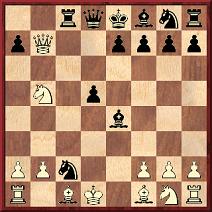
10 Nd6+ exd6 11 Bb5+ Resigns.
Salo Flohr – Wollevleski(?)
Tel Aviv, 31 May 1934
Queen’s Gambit Declined
1 d4 d5 2 c4 e6 3 Nc3 Nf6 4 Bg5 Be7 5 e3 c6 6 Nf3 Nbd7 7 Qc2 a6 8 Rd1 b5 9 c5 Qa5 10 Nd2 e5 11 Be2 Qc7 12 O-O Bd8 13 Bh4 Qb8 14 Bg3 Bc7 15 dxe5 Nxe5 16 Nf3 O-O 17 Nd4 Bd7 18 e4 Neg4 19 exd5 Bxg3 20 hxg3 cxd5 21 Bf3 Qe5 22 Bxg4 Bxg4 23 Rd2 Rfe8 24 b4 Ne4 25 Nxe4 dxe4 26 Re1 Rad8 27 Nc6 Rxd2 28 Qxd2 Qf6 29 Nd4 Qe5 30 Qe3 Bc8 31 Ne2 Bb7 32 Rd1 Qb2 33 Qd2 Qe5 34 Nf4 f5 35 Qd7 Re7
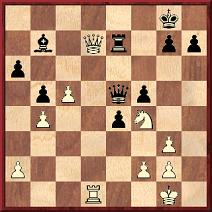
36 c6 Kf7 37 cxb7 Rxd7 38 Rxd7+ Ke8 39 Rxg7 Kf8 40 Rxh7 Kg8
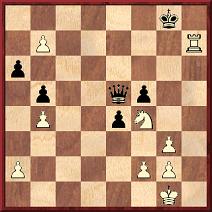
41 Rh8+ Resigns.
The third game, a loss by Flohr, occurred in a display against 11 strong players in which he scored + 9 – 1 = 1 in 4½ hours:
Dubkin – Salo Flohr
Tel Aviv, 2 June 1934
Caro-Kann Defence
1 e4 c6 2 d4 d5 3 Nc3 dxe4 4 Nxe4 Bf5 5 Ng3 Bg6 6 Nf3 Nd7 7 Bd3 e6 8 O-O Ngf6 9 Re1 Qc7 10 Ng5 Bxd3 11 Qxd3 Bd6 12 Bd2 O-O 13 Rad1 Rad8 14 c4 c5 15 d5 exd5 16 cxd5 Nb6 17 Nh5 Nbxd5 18 Bc3 h6 19 Bxf6 hxg5 20 Bxd8 Rxd8 21 Qf5 Nf4 22 Qxg5 Nxh5 23 Qxh5 Bf8 24 g3 a6 25 Qh4 Rxd1 26 Rxd1 Qe5 27 Rd8 g6 28 h3 Kg7 29 Rc8 g5 30 Qg4 Be7 31 Re8 Qd6 32 h4 Qf6 33 h5 Kh6 34 Qc8 Resigns.
The photograph below shows Flohr giving an exhibition in Prague and comes from page 33 of the February-March 1935 Československý Šach:
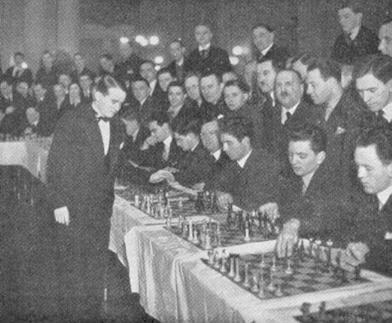
(3962)
From the Salo Flohr entry on page 139 of The Encyclopaedia of Chess by Anne Sunnucks (London, 1970):
‘In Czechoslovakia he became a national hero, and Salo Flohr collars, Flohr slippers, Flohr cigarettes and Flohr eau-de-Cologne appeared on the market.’
This relates to the 1930s, but what hard facts exist about such merchandising?
(4177)
We have now found the following by George Koltanowski on page 440 of CHESS, 14 August 1936:
‘Prague has Salo Flohr collars, Flohr slippers, Flohr cigarettes (he is a non-smoker, too!), Flohr eau-de-Cologne, etc.’
Koltanowski wrote similarly about Flohr on pages 54-55 of his book “En Passant” Chess Games and Studies (Edinburgh, 1937):
‘If you happen to stroll round Prague, a look at the various shop displays will give striking evidence of his fame. Here can be seen Flohr collars, Flohr slippers, Flohr Eau de Cologne, and (although he is a non-smoker himself), Flohr cigarettes, and so on.’
Wanted: corroboration of this in a dependable source.
(4187)
No substantiation has been found of claims by George Koltanowski, published in 1936 and 1937, that in Prague it was possible to find ‘Flohr collars’, ‘Flohr slippers’, ‘Flohr cigarettes’ and ‘Flohr eau-de-Cologne’.
With regard to footwear, Thomas Niessen (Aachen, Germany) draws attention to a brief interview with Salo Flohr on page 13 of De Telegraaf, 22 March 1932. Flohr stated that he hoped to persuade the shoe manufacturer Tomáš Bat’a (Zlín, Czechoslovakia) to finance the greatest chess tournament of all time, with a fund of 300,000-400,000 Czech crowns. Less than four months after the interview was published, Bat’a died in a plane crash.
A brief news item on page 262 of the June 1932 BCM had stated:
‘... Zlín, where it is proposed to hold a grand masters tournament in October, is a thriving city and the home of the great Bata shoe-factory, which employs 25,000 hands.’
Mr Niessen points out that possible involvement in chess by the Bata company was also discussed in the late 1930s. Národní politika, 8 February 1938, page 10, reported that Flohr would be giving a simultaneous exhibition in the chess section of the Club SK Bata in Zlín in early March and would be discussing with the Bata management the possible organization of a world championship match in Zlín in 1940 (against Alekhine or Capablanca).
From page 302 of the 14 May 1938 CHESS:
‘“What has been decided?”, we asked Dr Alekhine, “with regard to an eventual match against Flohr?”
“I go to Prague at the end of May and will discuss there with Flohr and, probably, the representatives of the Czechoslovakian Chess Federation the arrangements of a possible match at the end of 1939.”
Rumour says that Bata, the Czechoslovakian boot and shoe magnate, is keenly interested in Flohr’s challenge and willing to finance a match.’
Page 215 of the May 1938 BCM reported:
‘... it is now fairly certain that Dr Alekhine will play S. Flohr next year at Zlín, in Czechoslovakia.’
In World Championship Disorder we commented that ‘there has probably never been another period in chess history with so many “projected matches” that failed to materialize’.
(9677)
C.N. 2857 (see page 228 of Chess Facts and Fables) quoted the following from page 25 of G. Koltanowski’s 1968 book TV Chess:
‘In 1933 Salo Flohr played a match with Henry Grob, only Swiss pro. Salo, the former Czechoslovakian chess marvel, won the match five to one. [The result was, in fact, +4 –1 =1.] In the game he lost, the following position occurred:
Black to move played 1…Qb5 and White resigned.
In 1953, 20 years later, Salo Flohr returned to Switzerland, now a full-fledged Russian and as a second to one of the Soviet players competing in the Candidates Tournament in Zurich.
On meeting Grob, Salo did not say “How are you?” Oh, no! The first words he uttered were, “You know, the game I lost to you 20 years ago was a win for me!” Grob was flabbergasted. He couldn’t even remember the position! It seems that a few years after that particular game, giving an exhibition somewhere in Russia, Flohr encountered a schoolboy, who asked him why he had resigned his game against Grob. “Why”, said Flohr, “because I was lost.” “Did you consider after 1…Qb5 2 Kh1?” was the quiet answer. Flohr has been smarting since!’
We indicated in C.N. 2857 that, in reality, the possibility of Kh1 had been pointed out by almost all magazines which published the game in 1933.
Koltanowski’s sweepings are, as usual, of unidentified provenance, but a recent browse through Test your chess by Gerald Abrahams (London, 1975) has presented us with an additional complication. Position 3 was as follows:
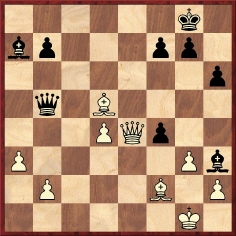
‘In this position, White, to move, resigned. Was that a mistake?’
The following is the solution later in the book (which had no page numbers):
‘This position constitutes the close of a game played by no less than Salo Flohr (White) against the Swiss player Grob in the 1930s.
It looks as if Kh1 for White saves the game; and Flohr, under time-pressure, may have missed this. If 1 Kh1 Qf1+ 2 Bg1.
Perhaps an opponent can be trusted to find what Russian analysts pointed out a few years later, but which is not terribly hard to see: 2...Bxd4!
In answer to this, 3 Qe8+ Kh7 4 Be4+ f5 comes to nothing. Also the sacrifice 3 Bxf7+ can be easily worked out as not leading to a perpetual check.
Acceptance of Black’s sacrifice by 3 Qxd4 is answered by 3...f3, which threatens mate. There follows: 4 Bxf7+ Kxf7 5 Qd5+ Kg6! 6 Qe4+ Bf5 wins.
It therefore appears that White’s position was a lost one, given good play, not easy to analyse, by the opponent ...
Years later, when the justification of his resignation was brought to his notice, Flohr commented: “You thought about it for six years, but I resigned then and there.”’
Whether this alleged dialogue is any more credible than Koltanowski’s script is unclear, but at least Koltanowski’s book had the correct position, whereas Abrahams put a black, not white, pawn on f4 and gave a different queen’s-side pawn configuration.
He was not the first to do so. The conclusion to the game was discussed on pages 99-100 of Der letzte Fehler by Klaus Trautmann (Schwieberdingen, 1999). He related that in 1965 Giorgio Porreca gave the position in L’Italia Scacchistica with a black pawn at f4 (and the incorrect queen’s-side pawns), and that the matter was picked up by Horst Ewald in the 3/1966 issue of Schach. Porreca stated that his source had been a Russian brochure by Boris Wainstein, and much of the discussion involved establishing the correct game-score, a matter not in dispute today. We should, though, like to know when the position first appeared in print as in the second diagram above.
It was the opening game in the Flohr v Grob match, played in Arosa, Switzerland from 26 February to 3 March 1933 (Schweizerische Schachzeitung, March 1933, page 37). Some later books misdated the game 1932, examples being page 275 of The Joys of Chess by F. Reinfeld (New York, 1961) and page 79 of Blunders and Brilliancies by I. Mullen and M. Moss (Oxford, 1990).
(4309)
From Christian Sánchez (Rosario, Argentina):
‘C.N. 4309 asked when the wrong position from Flohr v Grob first appeared in print and referred to “a Russian brochure by Boris Wainstein”. The position in question was given on pages 53-55 of Wainstein’s book Kombinatsii i lovushki v debyute (Moscow, 1965). See also pages 52-53 of the Spanish translation, La trampa en la apertura (Barcelona, 1967).
Wainstein (or Weinstein) states that the story had appeared previously, told by Ferzberi (i.e. Wainstein himself). It is essentially the same as Gerald Abrahams’ version, with the addition of Bronstein as the master who found the winning line for Black and told Flohr.’
(4382)
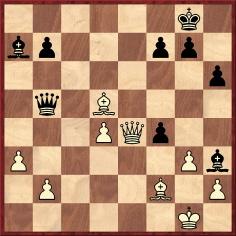
C.N. 4309 asked about the first publication of the above erroneous diagram (erroneous because, in addition to the misplacing of the queen’s-side pawns, the pawn at f4 should be white).
Richard J. Hervert (Aberdeen, MD, USA) notes that the diagram appeared on page 13 of the first edition of Gerald Abrahams’ Test your chess (London, 1963). The solution on the following page was:
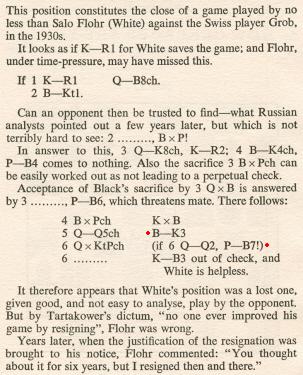
Our correspondent remarks that 6...f2 is an oversight, since 7 Qxf2 gives check. The 1975 edition of Abrahams’ book corrected the sequence to 5 Qd5+ Kg6 6 Qe4+ Bf5, and Black wins.
(6482)
Avital Pilpel notes that two early specimens of Salo Flohr’s play were included in a book by Yosef Porat and Eliahu Fasher, Yosef Porat Aman ha’Sachmat, 70 Mishakim Nivharim, which was published in Israel in 1989. The first of them, from page 21, is given below, with Porat’s notes translated by our correspondent. Played in a friendly match between the Silesian and Czechoslovakian German Chess Associations circa September 1928 (‘a few weeks after the July 1928 Olympiad in The Hague’), it is a loss by Flohr to Porat (who was then named Heinz Joseph Foerder):
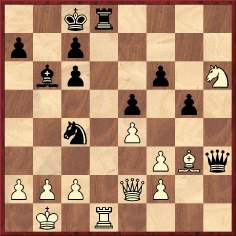
‘Position after 24 ...Qxh3. The white bishop is in a cage.’ 25 Ng4 Rxd1+ 26 Qxd1 Qh8 27 a3 Nd6 28 Qd3 Qd8 29 Qb3 Kd7
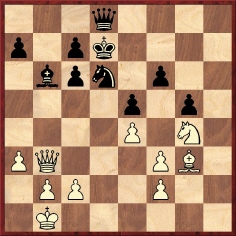
30 Qg8 ‘A small combination with a hole in it. White wins a pawn, but the knight is put in a cage as well.’ 30...Qxg8 31 Nxf6+ Ke6 32 Nxg8 Nf7! ‘Closing the cage. Now Black needs to manoeuvre so as to win the knight without losing the pawn at e5.’ 33 Kc1 Bc5 34 Kd2 Bf8 35 Kd3 Nd6 36 Bh2 Bg7 37 c3 Nc8 38 Kc4 Bf8 39 b4 Nb6+ 40 Kb3 Nd7 41 Ka4 Kf7 42 Ka5 Kxg8 43 Ka6 c5 44 Kxa7 cxb4 45 cxb4 c5 46 bxc5 Bxc5+ 47 Kb7 Kf7 48 a4 Bxf2 49 a5 Nc5+ 50 White resigns.
Is the earlier part of the game extant?
(4402)
A number of items (see pages 330-332 of Chess Facts and Fables and C.N.s 4328 and 4366) have discussed the story that Nimzowitsch complained about an opponent who threatened to smoke, the defendant being identified, in the various versions, as either Vidmar or Lasker. Now we note that in CHESS, 30 September 1963 (‘page 400’, but in fact page 12) Salo Flohr brought in a different name:
‘I remember an incident involving Grandmaster Nimzowitsch. He couldn’t bear tobacco smoke, and in one tournament he set as a condition that his opponent should not smoke.
His rivals agreed. When Bogoljubow put a full box of cigars on the table before sitting down to play against him, he hurried to the chief umpire in great excitement.
The umpire checked up and said, “But Bogoljubow isn’t smoking”.
“I know he isn’t”, Nimzowitsch fumed, “but he threatens to do so, and the threat in chess is more powerful than the execution.”’
Flohr was not necessarily claiming to have been an eye-witness, but it may be recalled that the incident is usually placed at New York, 1927, where neither Bogoljubow nor Lasker participated.
(4496)
See A Nimzowitsch Story.
The article by Flohr mentioned in the previous item also contained the following:
‘Chess, like love, is infectious at any age.’
This has become a famous quote, being featured at the start of The Most Instructive Games of Chess Ever Played by Irving Chernev (New York, 1965). Since it is often cited without a source, we should like to know more about the genesis of Flohr’s article in CHESS, which was entitled ‘How to become World Champion’. Was it an original piece for the magazine or a translation from, for instance, a Soviet publication?
Below is an inscription by Flohr in one of our copies of 300 Izbrannikh Partii Alekhina by V. Panov (Moscow, 1954):
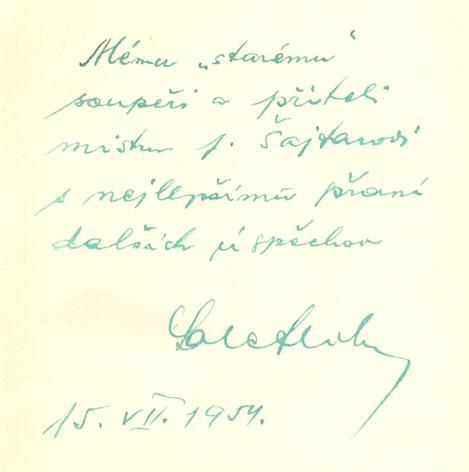
English translation: ‘To my old rival and friend, master J. Šajtar, with best wishes for future successes. Salo Flohr 15.VII.1954.’
(4497)
A photograph of Alekhine and Flohr in Nice, 1931, from page 284 of A Chess Omnibus:
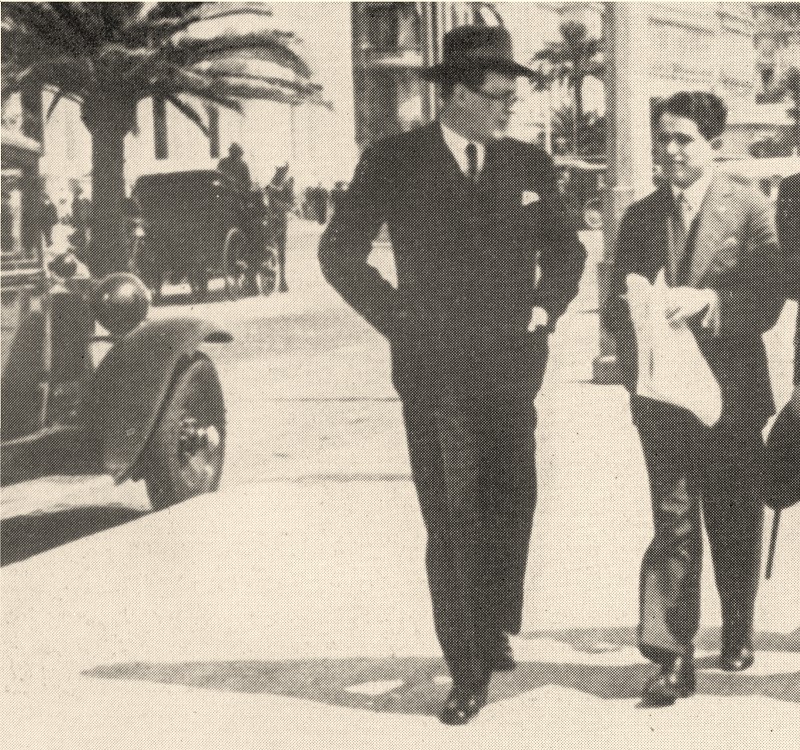
The conclusion to Fischer’s draw against Botvinnik at the Varna Olympiad in 1962 has given rise to discussion on a human level. On page 153 of Analiticheskiye I Kriticheskiye Raboti 1957-1970 (Moscow, 1986) Botvinnik reported that Fischer was distraught as he left the hall. To quote the English translation on page 183 of volume three of Botvinnik’s Best Games (Olomouc, 2001):
‘Only here, with his face [as] white as a sheet, did Fischer shake my hand, and with tears in his eyes he left the hall.’
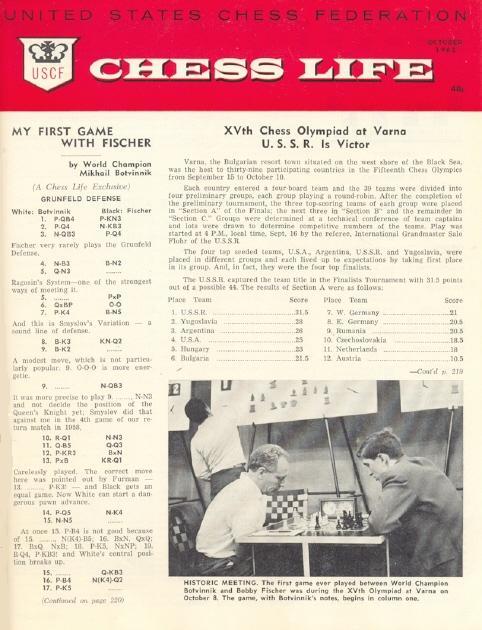
The matter arose on page 137 of the September 1963 Chess World when C.J.S. Purdy was discussing Alexander Kotov:
‘I also knew that he was a very kindly writer. I have never known him to treat anyone unkindly in print. By contrast, his countryman Flohr, a clever journalist, handled Bobby Fischer almost spitefully, when he reported that after he had only succeeded in drawing with Botvinnik in Varna, after having a winning advantage, he left the room and, having reached the corridor, burst into tears. As Fischer probably thought he was alone by then, it was cruel to record such a thing, but Flohr knew it was good “copy”. Kotov would never initiate such a story. Nor would I myself; I am prepared to use it once it has been made public already, for I am not a censor, but I think Kotov is too kind even to do that ...
I do not decry Flohr. There is virtue in sheer truth. But Flohr could have written sympathetically or purely factually, without spiteful overtones.’
Can a reader quote Flohr’s exact words?
(4595)
A photograph included in Crowds at Chess Events, from page 416 of CHESS, 14 July 1936:
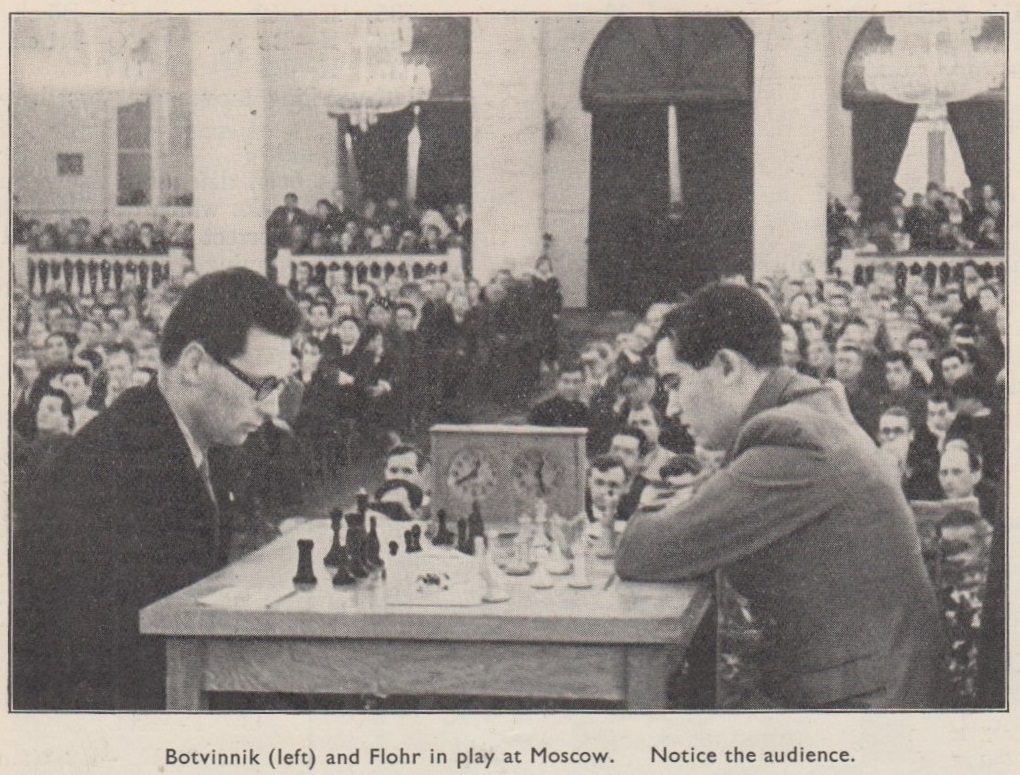
Four outdoor photographs of the masters were published in the Chess Review, September 1936 (pages 200, 203, 204 and 211):
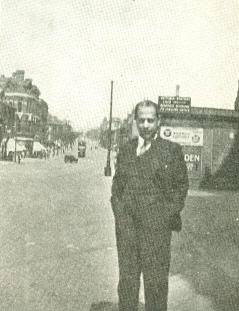
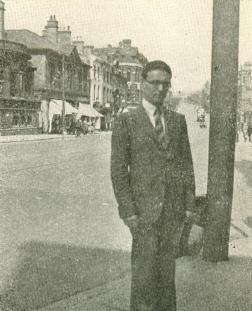
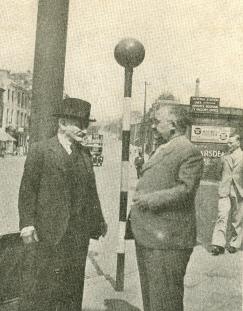
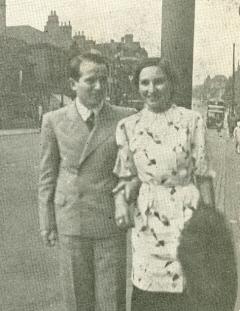
Left to right: José Raúl Capablanca, Mikhail Botvinnik, Emanuel Lasker and Milan Vidmar, Salo Flohr and his wife.
Page 7 of CHESS, 14 September 1936 had a picture of the wives of Euwe, Botvinnik and Flohr:
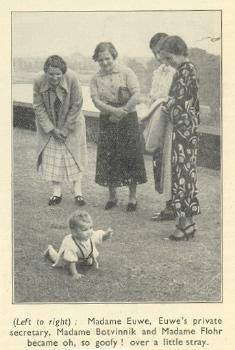
(4935)
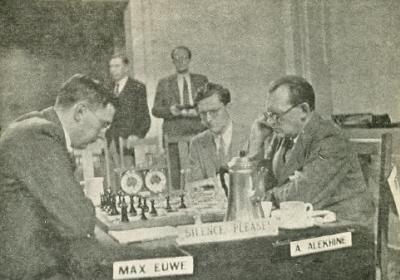
See our feature article on Nottingham, 1936.
From Oliver Beck (Seattle, WA, USA):
‘In a bookstore I recently came across two boxes of books and other rare and interesting chess material which once belonged to Paul Hugo Little (Litwinsky). C.N. 4935 showed him at the board with Euwe and Alekhine during their game at Nottingham, 1936, in a photograph taken from Chess Review, and I wonder if he was seated there as an indirect result of the disturbance created by Euwe and others during the Flohr v Capablanca game in the third round (see A.J. Mackenzie’s comments on page 3 of the tournament book, as well as Alekhine’s note to Capablanca’s 37th move on page 59), although he may have received that privilege through his donation of prizes (page xiv). I am interested in learning more about this incident, which may have cost Capablanca sole possession of first place.
Little, who died in 1987, was an interesting character. His many notes in the material I acquired show him to have been a stickler for detail and accuracy. For example, among the newer books is a copy of With the Chess Masters which was signed and dedicated to him by George Koltanowski. This, however, did not stop Little from correcting it throughout with a ballpoint pen, finding many of the errors you pointed out on page 160 of Chess Explorations.’
Below are the passages by Alekhine and Mackenzie referred to by our correspondent:
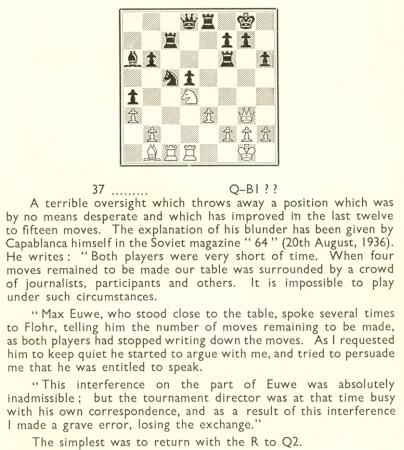
Above: from Alekhine’s notes to Flohr v Capablanca, in the Nottingham, 1936 tournament book (with incorrect diagram)
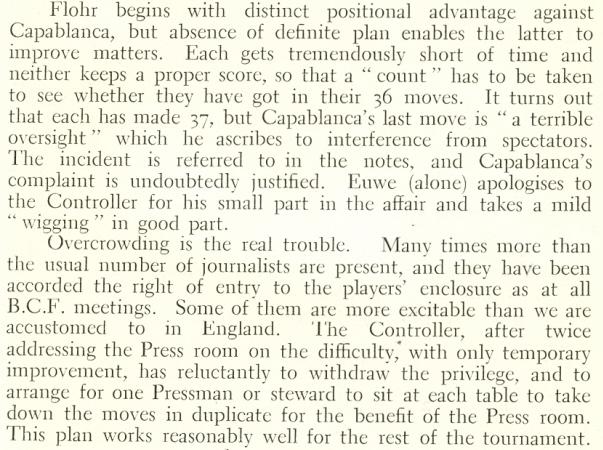
From A.J. Mackenzie’s round-by-round commentary in the Nottingham, 1936 tournament book
An English translation (by Kenneth Neat) of all Capablanca’s notes to the Flohr game on page 2 of the 20 August 1936 issue of 64 appeared on page 279 of our book on the Cuban. Moreover, C.N. 211 mentioned that on page 166 of The Great Chess Tournaments and Their Stories (Radnor, 1975) A. Soltis expressed unjustified doubts about the account:
‘The only problem with Capablanca’s version of the incident is that the time limit was 36 moves in two hours, not 40. This would mean that Black’s blunder came after the time control.’
There is, though, a simple explanation. C.N. 211 quoted from page 314 of the Australasian Chess Review, November 1936:
‘The players were now so clock-pressed that they had not even been able to write down their last few moves. At any rate, Capablanca had not. Therefore, he did not know that he had made his 36. Hence this clock-blunder when the race was actually over.’
See also pages 432-433 of the September 1936 BCM and, in particular, the note to 37...Qc8:
‘Both players were so short of time they did not even know how many moves they had made. This explains the repetition of moves, and also their meaningless manoeuvres; and also how it happened that Black made a mistake when the time-limit was finished.’
As regards P.H. Little, when still in his teens he had chess poetry published (American Chess Bulletin, September-October 1934, page 127 and December 1934, page 162). He later wrote non-chess fiction (under pseudonyms) and non-chess non-fiction. In the latter category we own an inscribed copy of The Juvenile Delinquent (New York, 1971), which had a five-page Introduction by Reuben Fine.
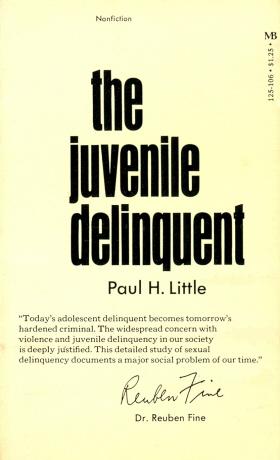
(5292)
Two photographs from opposite page 64 of Caïssas Weltreich by Max Euwe and Bob Spaak (Berlin-Frohnau, 1956):
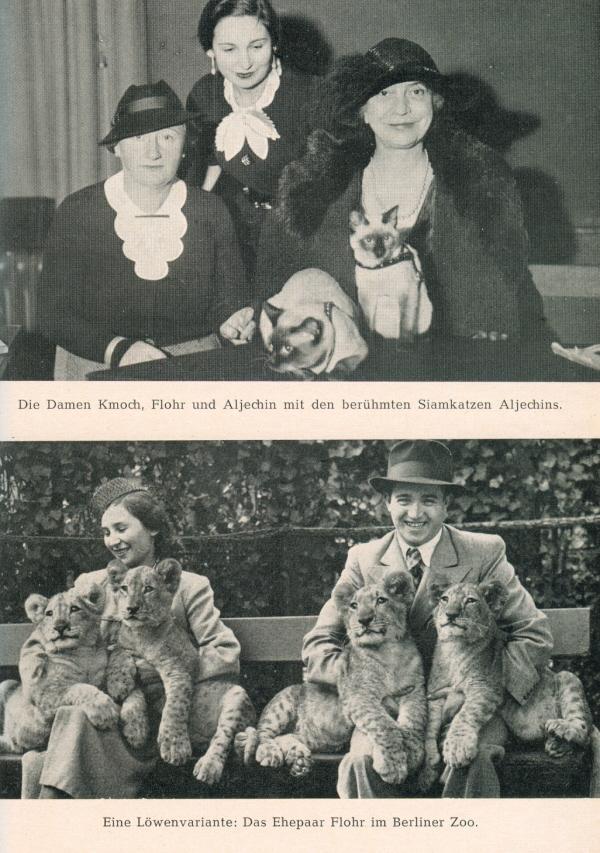
(5575)
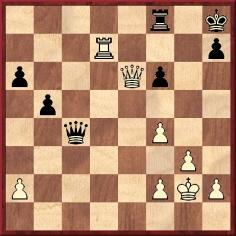
In this position, Black has just played 32...Qc1-c4. White exchanged queens and brought about his opponent’s resignation at move 46. This ending (Flohr v Noteboom, Hastings, 1930-31) was discussed on pages 4-6 of Practical End-Game Play by Fred Reinfeld (London, 1940), but when a copy of the book was awarded to C.G. Watson a decade later C.J.S. Purdy wrote on page 240 of Chess World, 1 October 1950:
‘Thanking us for it, he characteristically pointed out a flaw in the very first position in the book – “just to show he had looked at his prize”.
... Flohr exchanged queens and won a hard endgame. Instead, Watson points out a very pretty smash by 33 Q-K7 Q-N1 (forced) 34 R-Q8.
Black has to accept the rook, then White quickly wins it back, swaps queens, then plays K-B1 with two pawns up and a fatuously easy win in the pawn ending.’
Below is the full game, from page 14 of Československý Šach, January 1931:
Salo Flohr – Daniël Noteboom
Hastings (Premier Reserves), 2 January 1931
Nimzo-Indian Defence
1 d4 Nf6 2 c4 e6 3 Nc3 Bb4 4 Qc2 c5 5 dxc5 Bxc5 6 Nf3 b6 7 g3 Bb7 8 Bg2 d5 9 O-O dxc4 10 Qa4+ Bc6 11 Qxc4 Qc8 12 b3 Qb7 13 Bb2 Nbd7 14 b4 b5 15 Qb3 Be7
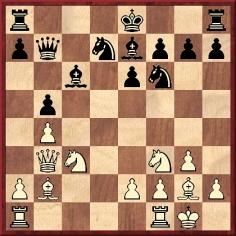
16 Bh3 Bxf3 17 exf3 O-O 18 f4 Rad8 19 Rfe1 a6 20 Bxe6 Bxb4 21 Qxb4 fxe6 22 Rxe6 Rde8 23 Rae1 Rxe6 24 Rxe6 Qc8 25 Ne4 Nxe4 26 Rxe4 Nf6 27 Re7 Qd8 28 Qb3+ Kh8 29 Qe6 Qc8 30 Bxf6 gxf6 31 Rd7 Qc1+ 32 Kg2 Qc4 33 Qxc4 bxc4 34 Rc7 Rb8 35 Rxc4 Rb6 36 Rc7 Rb2 37 Rc6 Rxa2 38 Rxf6 Kg7 39 Rb6 Ra5 40 g4 Ra4 41 Kg3 Ra3+ 42 f3 h6 43 h4 a5 44 g5 h5 45 f5 Ra1 46 Rb7+ Resigns.
Flohr contributed some notes to the Czech magazine but wrote nothing after move 20.
(5617)
Jan Kalendovský (Brno, Czech Republic) submits this photograph:
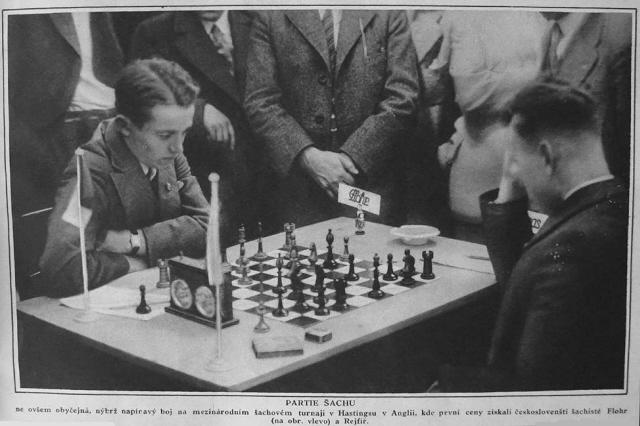
The caption is misleading, but can readers identify Black? It is possible to do so without consulting a games database.
(5659)
The Czech caption to this photograph states:
‘A game of chess
Though not a commonplace one but an exciting battle in the international chess tournament at Hastings in England, where the first prizes were won by the Czechoslovak chessplayers Flohr (on the left of the picture) and Rejfíř.’
In reality, the photograph was taken at the Prague, 1931 Olympiad, and Flohr was in play against Mikėnas.
(5676)
From the archives of Frank Anderson comes this photograph (Amsterdam, 1954), forwarded to us by John Donaldson (Berkeley, CA, USA):
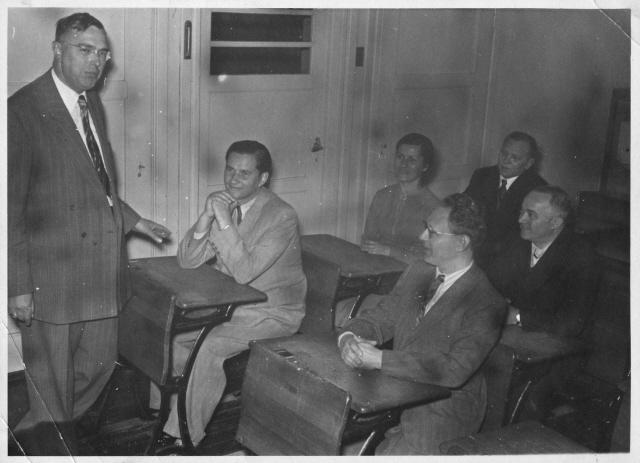
The caption on the original states: ‘M. Euwe, Keres, Mrs Botvinnik, Postnikov/Botvinnik, Flohr’.
(5798)
One of Salo Flohr’s most famous games – see, for instance, pages 40-44 of The Most Instructive Games of Chess Ever Played by Irving Chernev (New York, 1965) – is his victory over Rafael Domènech at Rosas, 1935. Although White is customarily said to have given up in the pawn ending after 30 Kxd2 Kd6, the game continued 31 c5+ Kxc5 and ‘White resigned a few moves later’ according to Flohr in his notes on page 337 of El Ajedrez Español, July 1935.
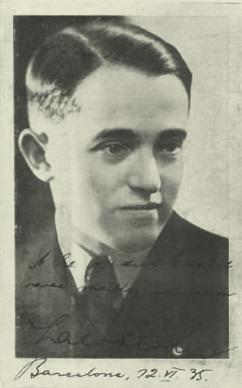
Salo Flohr (El Ajedrez Español, July 1935, opposite page 336)
Biographical details regarding Domènech are sought. This small photograph of him was published on page 506 of the December 1935 issue of the Spanish magazine:
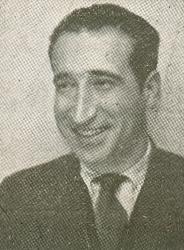
We use the spelling Domènech, with an accent, since his name was written that way in a magazine to which he regularly contributed, Els Escacs a Catalunya. Here, for example, is the mast-head of the January-February 1936 issue:
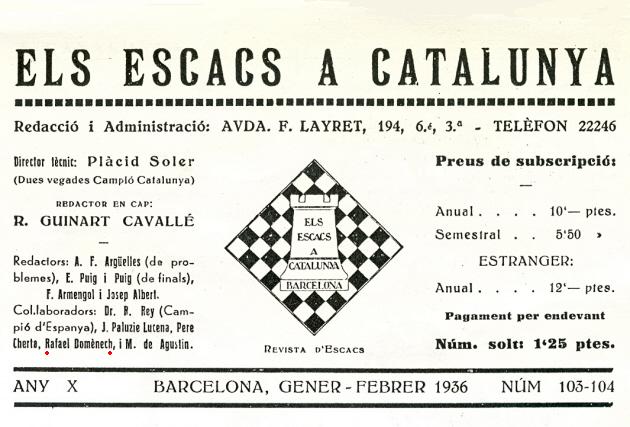
(5849)
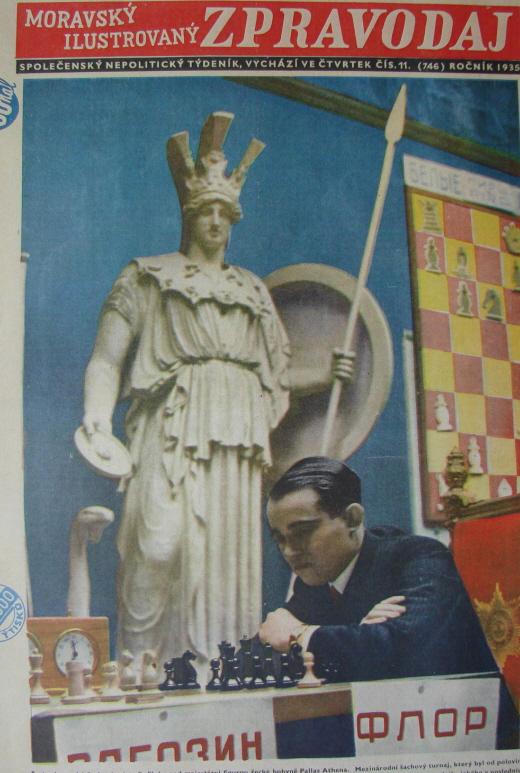
The front cover of the 11/1935 issue of Moravský ilustrovaný zpravodaj has been submitted by Jan Kalendovský and prompts us to set a little quiz question: which game is featured on the demonstration board?
(6319)
To gauge by the number of correct replies received, the little quiz question was, as anticipated, fairly easy. Given that Flohr is pictured in play against Ragozin (Moscow, 1935), it can be established from the tournament book (page 173) or a database that the demonstration-board position which arose in the same round (the third) showed Pirc v Lilienthal.
Some readers commented on the apparent absence of a white knight on b1, but on the basis of a darkened detail of the picture we tentatively suggest that the piece is there:
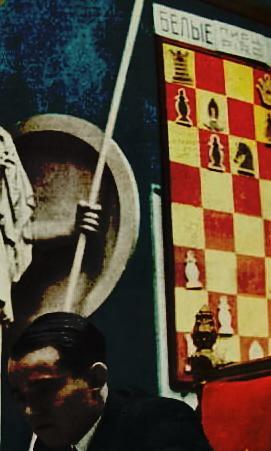
(6327)
A monochrome version of this photograph of Flohr in play against Ragozin at Moscow, 1935 occupied most of page 57 of the March 1935 Tidskrift för Schack.
(11387)
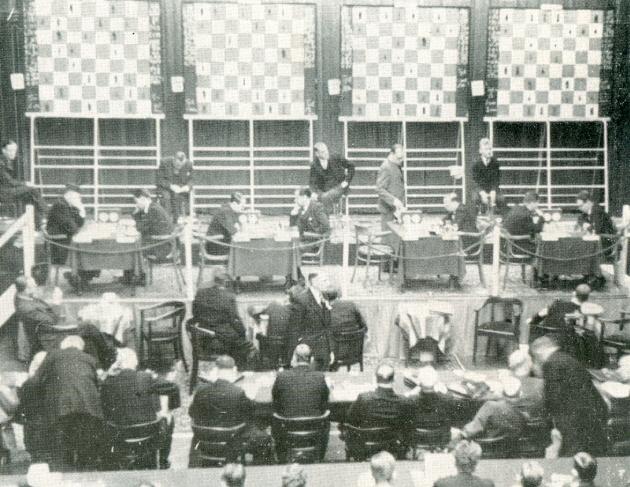
This photograph was taken in Amsterdam on 6 November 1938 during the first round of the AVRO tournament, the players being, from left to right, Euwe, Keres, Flohr, Capablanca, Alekhine, Reshevsky, Fine and Botvinnik. It was one of many shots from De Telegraaf reproduced on pages 139-142 of CHESS, 14 December 1938.
(6640)
For other photographs of Flohr at the AVRO tournament, see C.N.s 7191 and 7356.
Yakov Zusmanovich (Pleasanton, CA, USA) sends us, courtesy of Denis Shabalin and Sergei Voronkov, a photograph of Salo Flohr’s grave at the Vagankovo Cemetery in Moscow, shared with his second wife, Tatiana Flohr-Esenina:
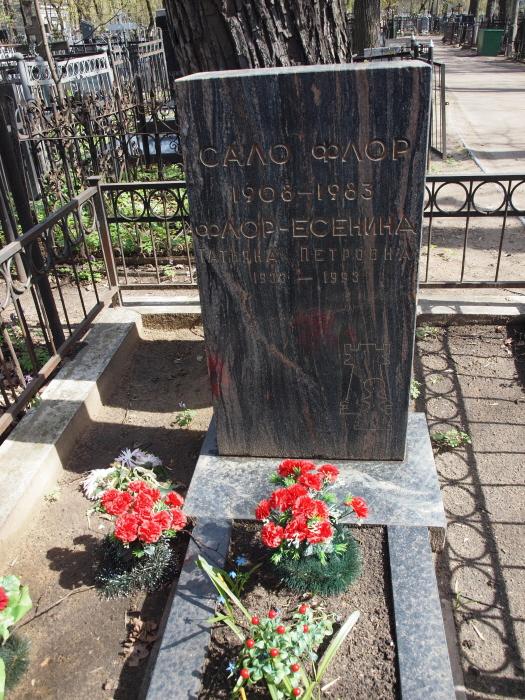
(6797)
From page 376 of the 14 July 1938 issue of CHESS:
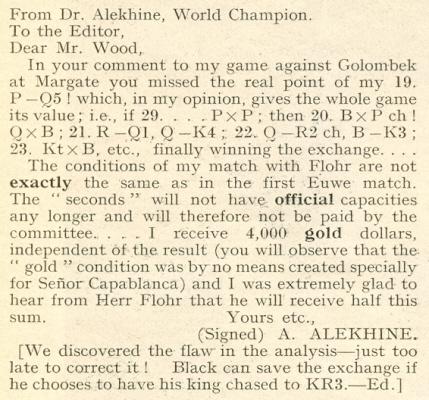
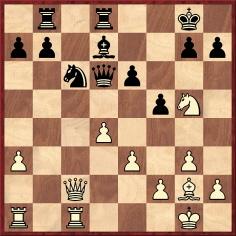
The position in the Alekhine v Golombek game (before 19 d5) had been given on page 360 of the 14 June 1938 CHESS, with this note:
‘Black might well have tried capturing the pawn, e.g. 19...PxP 20 R-Q1 Kt-K2 21 P-K4?! P-KR3 with some freedom.’
On the same page CHESS indicated the time taken on the game: one hour by White and two hours by Black.
Alekhine’s remark on the projected match with Flohr was in response to this paragraph on page 337 of the 14 June 1938 CHESS:
‘Dr Alekhine and Flohr have signed a contract for a world’s championship match in the autumn (fall) of 1939. The match will be played at various places in Czechoslovakia and the financial and other conditions are to be exactly the same as for the Alekhine-Euwe matches.’
(7063)
The obituary of Salo Flohr on page 8 of the November 1983 Ajedrez de Estilo stated that in 1923 he was defeated in 15 moves by Friedrich Sämisch in a simultaneous blindfold display.
Further information is sought.
(7080)
A comment on Flohr:
‘Almost impossible to beat but almost incapable of winning.’
Source: page 5 of The Groningen International Chess Tournament 1946 – analyses by M. Euwe commentaries by H. Kmoch (Sutton Coldfield, 1949).
From page 27 of the original Dutch edition, Groningen 1946 (Groningen, 1947):

(7091)
Karel Mokrý (Prostějov, Czech Republic) informs us that he investigated this Moscow, 1935 photograph in the 1980s and drew up the key given below:
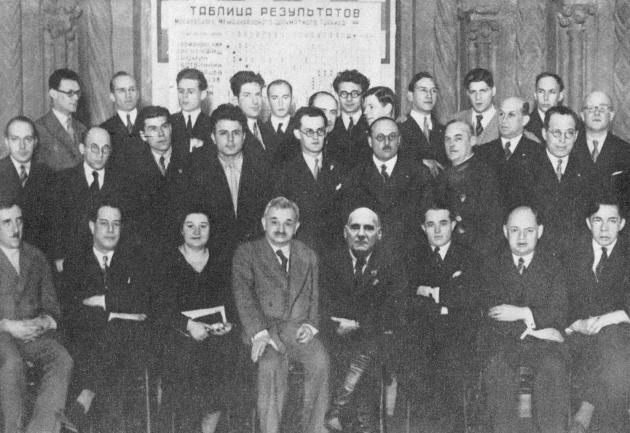
Mr Mokrý also mentions an article which he has written on the two variations of the Russian-language tournament book and the subsequent removal of Krylenko’s name and contribution. See under ‘Moscow 1935’ in the ‘Collector’s Corner’ of our correspondent’s webpage.
(7286)
From Photographs of Capablanca, a feature article which appealed for better copies of a number of images in Soviet publications:
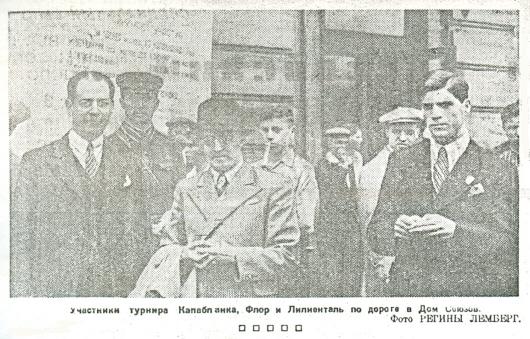
Source: Moscow tournament bulletin, 64, 16 May 1936
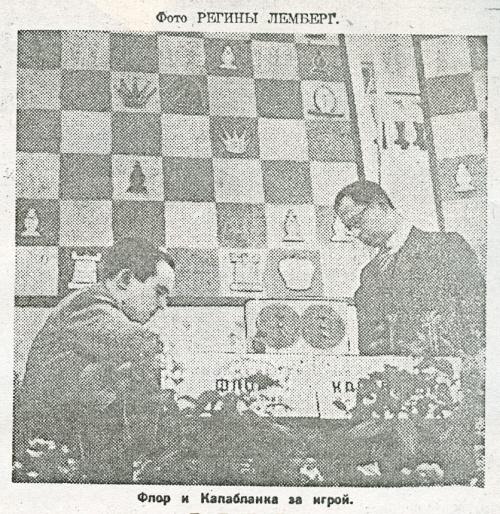
Source: Moscow tournament bulletin, 64, 17 May 1936
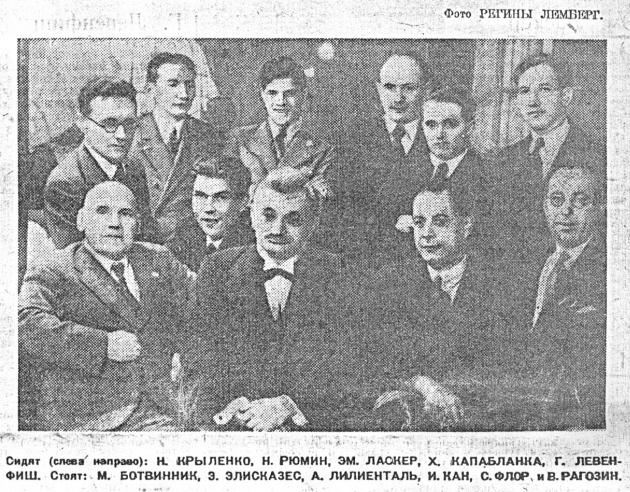
Source: Moscow tournament bulletin, 64, 13 June 1936 and 64, 16 June 1936, page 1
In C.N. 7301 Philippe Pierlot (Le Perchay, France) provided a good-quality copy (source not yet identified):
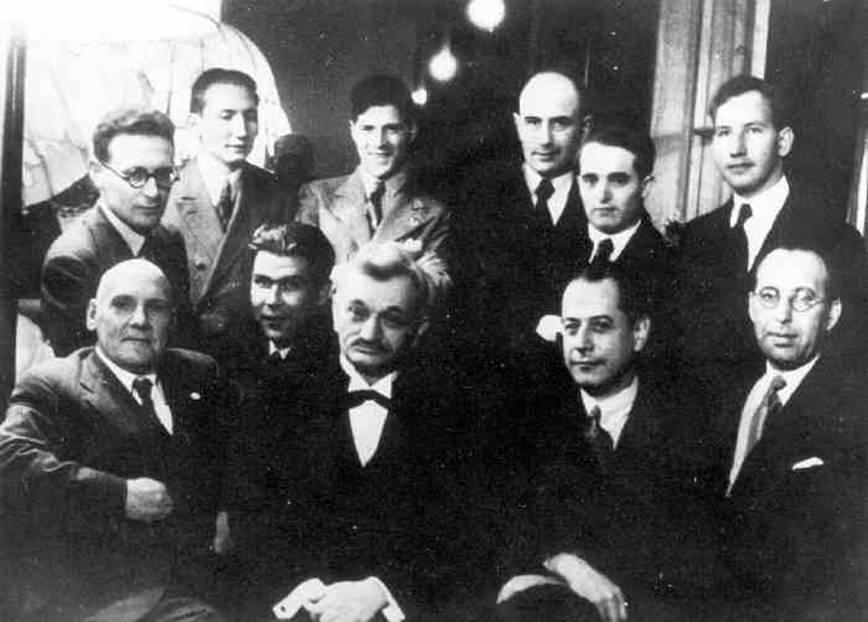
Below, from our archives, is a photograph taken during the 1953 Candidates’ tournament in Neuhausen and Zurich:
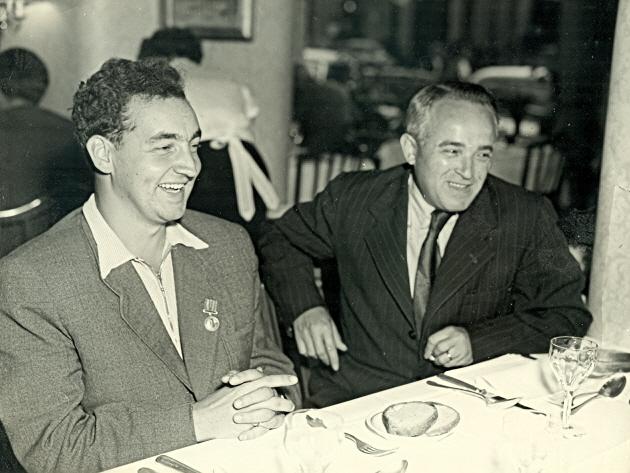
Mark Taimanov and Salo Flohr
(7355)
Two of many photographs from the Illustrated London News submitted by Olimpiu G. Urcan (Singapore):
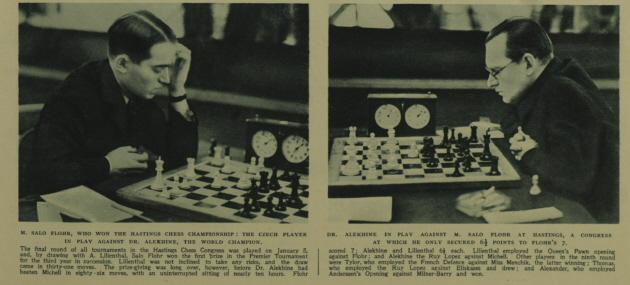
13 January 1934, page 67
(7490)
1 d4 d5 2 c4 e6 3 Nc3 Nf6 4 Bg5 Nbd7 5 e3 Be7 6 Nf3 O-O 7 Qc2 c6 8 a3 dxc4 9 Bxc4 Nd5 10 Bxe7 Qxe7 11 Ne4 N5f6 12 Bd3 Nxe4 13 Bxe4 h6 14 O-O e5 15 Rfe1 Qf6 16 Rad1 exd4 17 exd4 Nb6 18 Ne5 Be6 19 Re3 Rad8 20 Rf3 Qh4 21 g3 Qh5 22 h4 Bg4 23 Re1 Nd5 24 Rxf7 Rxf7 25 Bh7+ Kh8 26 Bg6 Qxe5 27 dxe5 Rff8 28 e6 Ne7 29 Bf7 Rd4 30 Qc5 Rfd8 31 Qxe7 Bf3 32 Qxd8+ Resigns.
This game was won by Salo Flohr against Karel Vaněk in a team match in Brno between Prague and Brno on 3 November 1929. He annotated it on pages 182-183 of the December 1929 Československý Šach, and a more detailed set of notes was provided by Tartakower on pages 9-11 of the January 1930 issue of Ajedrez (published in Valencia):
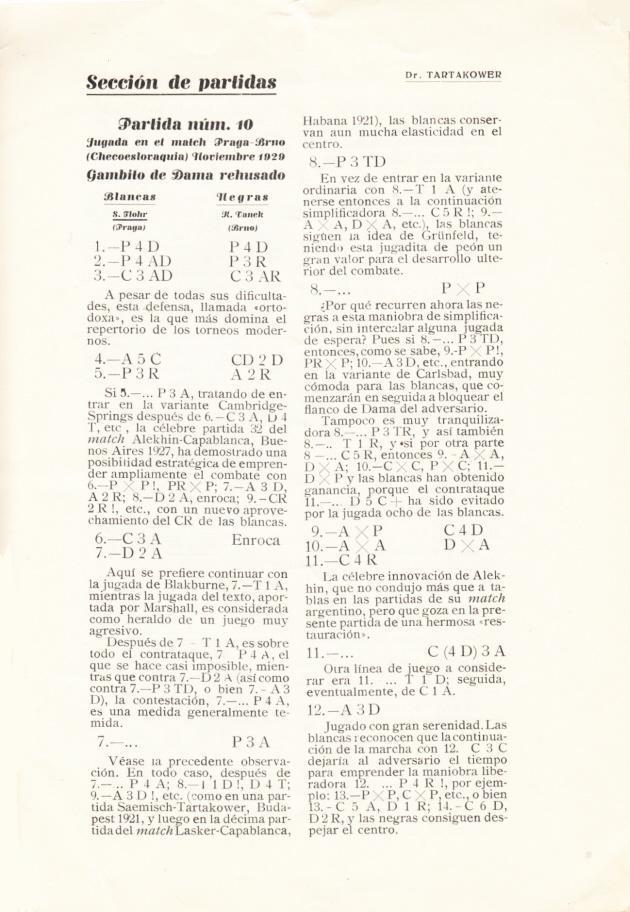
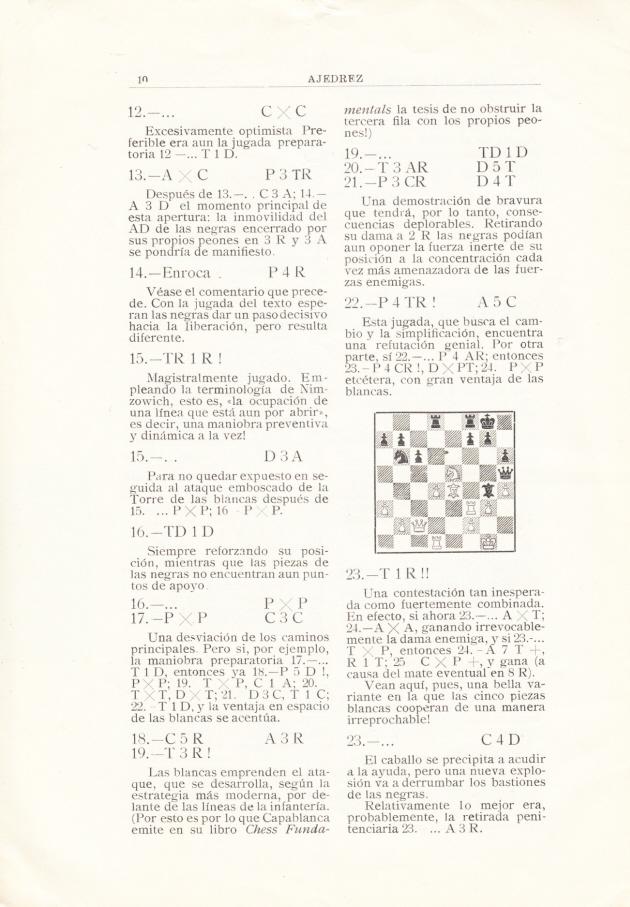
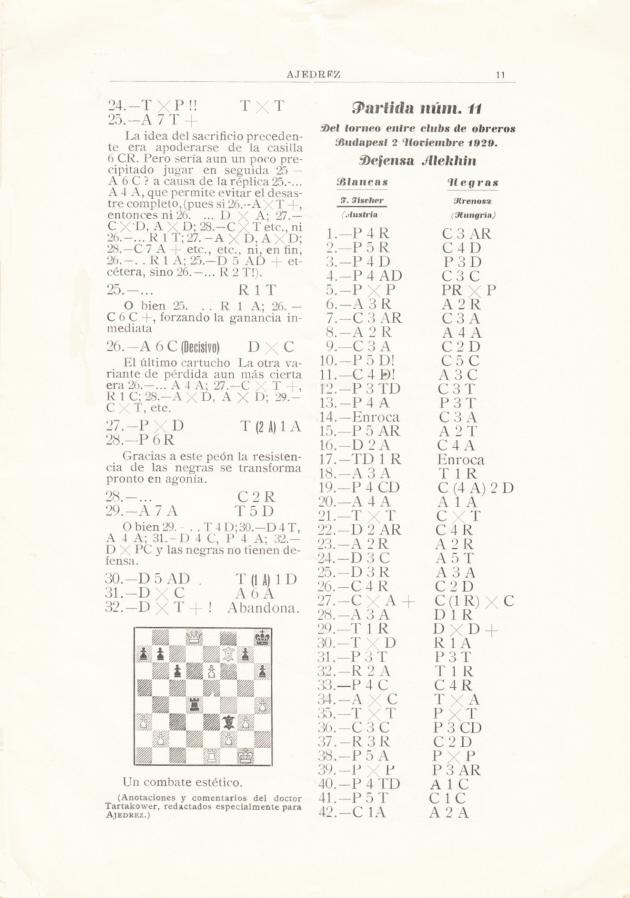
Readers are invited to compare Tartakower’s notes with those on pages 28-30 of Salo Flohr Master of Tactics, Master of Technique edited by Jimmy Adams (Nottingham, 1985).
(7918)
Bruce Monson (Colorado Springs, CO, USA) wonders what can be established regarding the photograph below, from Herman Steiner’s archives, beyond identification of Steiner on the left of the foursome and Salo Flohr on the right.
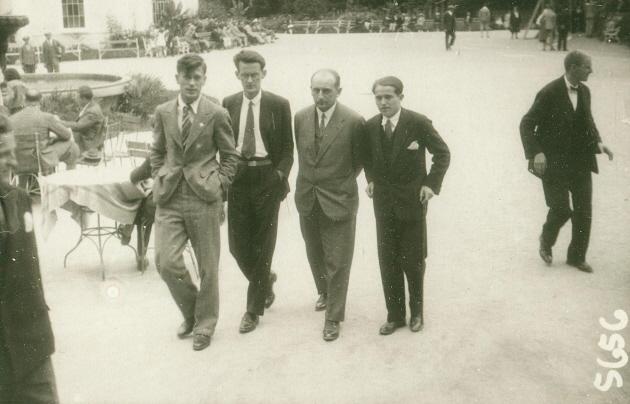
(8080)
Dan Scoones (Port Coquitlam, BC, Canada), Martin Weissenberg (Savyon, Israel) and Luc Winants (Boirs, Belgium) suggest that the players between Steiner and Flohr are Vasja Pirc and Karl Gilg, and that the photograph was taken during the tournament in Štubňanské Teplice, 1930.
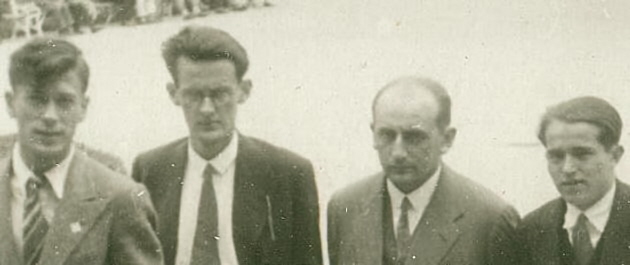
For photographs of Pirc and Gilg, see C.N.s 4052, 4532 and 6131.
(8084)
From B.H. Wood’s column in the Illustrated London News, 30 March 1963, page 482:
‘I know of only one book devoted to the saving of lost positions; that is, not unexpectedly, by Fred Reinfeld, who must in the course of his lifetime have racked his brain to think what he could write about next. (His enormous output once prompted David Bronstein to remark that, whilst — — [Wood’s dashes] might possibly be the best writer of chess books in the English language, Fred Reinfeld was obviously the best lightning-chess-writer.) Illuminatingly, this book is one of Reinfeld’s very latest, showing clearly that it is one of the last subjects that even occurred to such a prolific writer.’
And from Wood’s column on page 114 of the 28 May 1977 issue:
‘It was Flohr, I think, who compared him [Golombek] with Reinfeld, who also wrote a great many chess books, describing Reinfeld as the world’s worst lightning chess writer, Golombek as the best (lightning chess is the term for chess played at an average of a few seconds per move). The assessment is hard on Reinfeld; Bob Wade has remarked again and again how poorer players find him helpful. It is kind to Golombek, whose books sometimes exhibit a smooth sameness, who had one rather egocentric period and who can find it difficult (who does not?) to avoid repeating himself.’
Is anything further known about the views attributed to Bronstein and Flohr?
(8364)
Chapter XI (pages 53-56) of Lessons from My Games by Reuben Fine (New York, 1958) was entitled ‘I Become a Grand Master’, and on page 53 he reiterated a claim already made on page xv: that as a result of winning Hastings, 1935-36 he ‘was officially a grand master’. What is the factual basis of that statement?
Fine also asserted on page 53 that after his first-round victory over Flohr ‘first prize was never in any doubt’. He annotated the game not only in Lessons from My Games but also on pages 3-4 of the January 1936 American Chess Bulletin and on pages 166-167 of CHESS, 14 January 1936.
(8566)
Book inscriptions by one master to another are relatively scarce. An example from our collection is a dedication (‘with deep respect’) by Gufeld to Flohr:
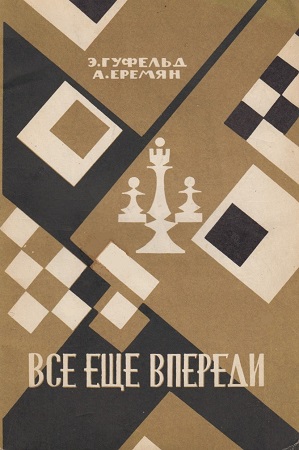
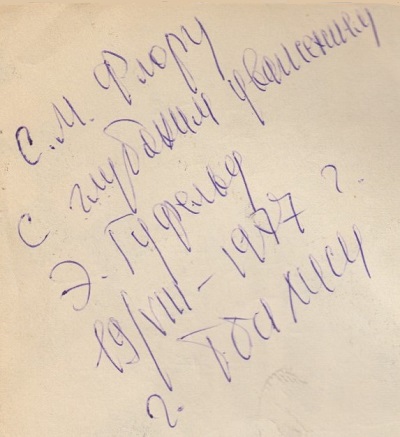
(9706)
Thomas Niessen (Aachen, Germany) provides an extract from page 7 of Národní politika, 29 July 1938:
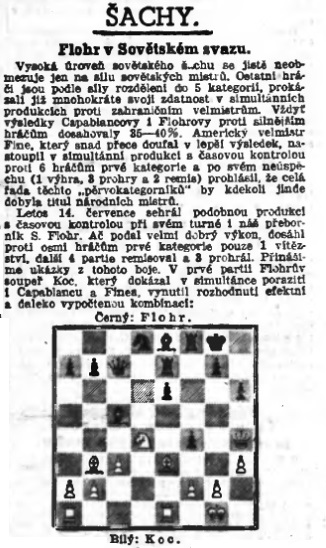
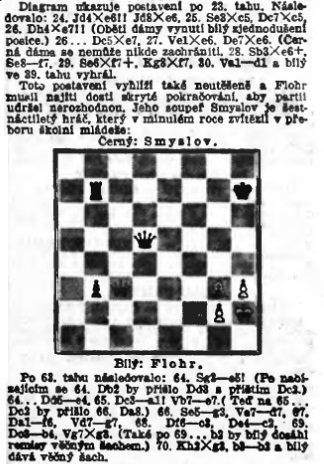
The report states that on 14 July 1938 Salo Flohr scored +1 –3 =4 in a simultaneous exhibition with clocks against first-category players.
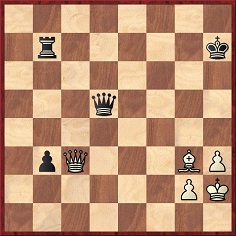
64 Be5 Qe4 65 Qa1 Re7 66 Bg3 Rd7 67 Qf6 Rg7 68 Qc3 Qc2 69 Qb4 Rxg3 70 Kxg3 b2 ‘and White gives perpetual check’.
Smyslov was aged 17.
(9740)
C.N. 10159 showed a picture of Koltanowski drawn by Henry Grob and published on page 1 of the 4 December 1936 issue of Schach-Kurier.
Richard Forster (Zurich) notes that it is one of five portraits of chess figures in Henry Grob: der Zeichner und Maler by Henry Grob (Zurich, 1965). They included Salo Flohr:
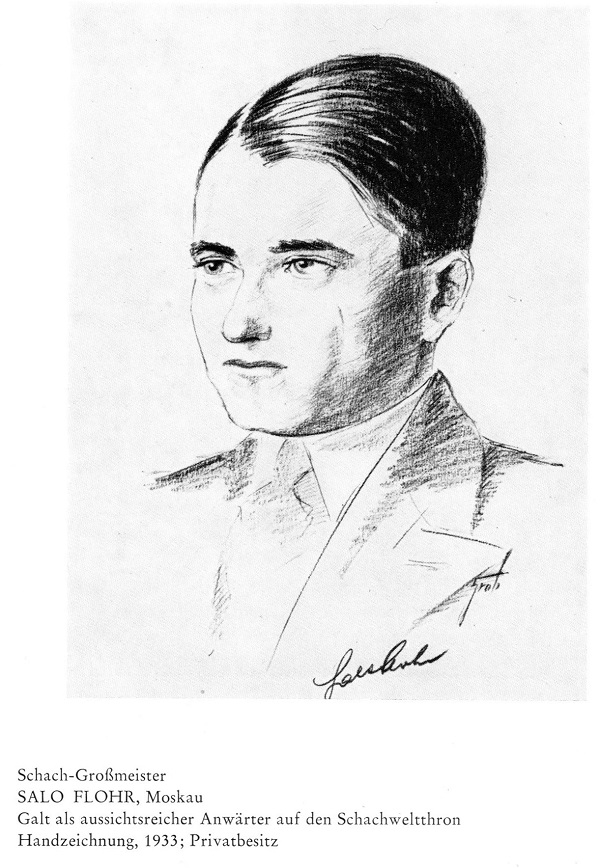
(10217)
One of many images in the Illustrated Sporting and Dramatic News from Olimpiu G. Urcan:
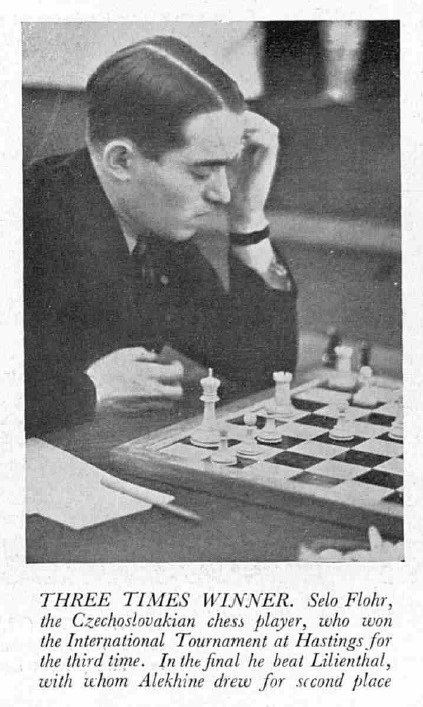
13 January 1934, page 64.
(10307)
From page 30 of the January 1957 Chess World:
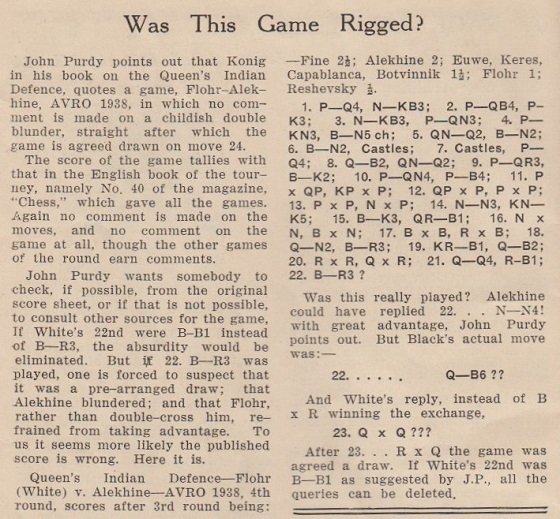
The question in the headline was answered on page 60 of the March 1957 issue:
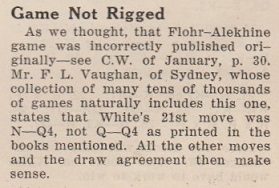
The full score of Flohr v Alekhine, AVRO, 12 November 1938: 1 d4 Nf6 2 c4 e6 3 Nf3 b6 4 g3 Bb4+ 5 Nbd2 Bb7 6 Bg2 O-O 7 O-O d5 8 Qc2 Nbd7 9 a3 Be7 10 b4 c5 11 cxd5 exd5 12 dxc5 bxc5 13 bxc5 Nxc5 14 Nb3 Nfe4 15 Be3 Rc8 16 Nxc5 Bxc5 17 Bxc5 Rxc5 18 Qb2 Ba6 19 Rfc1 Qc7 20 Rxc5 Qxc5
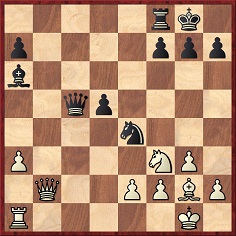
21 Nd4 Rc8 22 Bh3 Qc3 23 Qxc3 Rxc3 Drawn.
Apart from the two mentioned by Purdy, the sources that we have consulted state that White’s 21st move was Nd4, and not Qd4, with one notable exception: page 632 of the Skinner/Verhoeven volume on Alekhine.
The publications cited by Purdy are shown below, beginning with page 131 of the 14 December 1938 issue of CHESS (the sole source indicated by the Skinner/Verhoeven book):
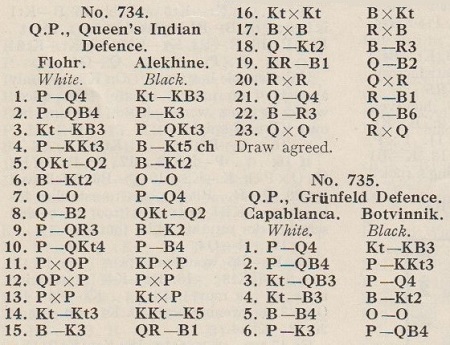
In the relevant part (pages 46-47) of König’s book The Queen’s Indian Defence (London, 1947) our copy has a handwritten correction at move 21:

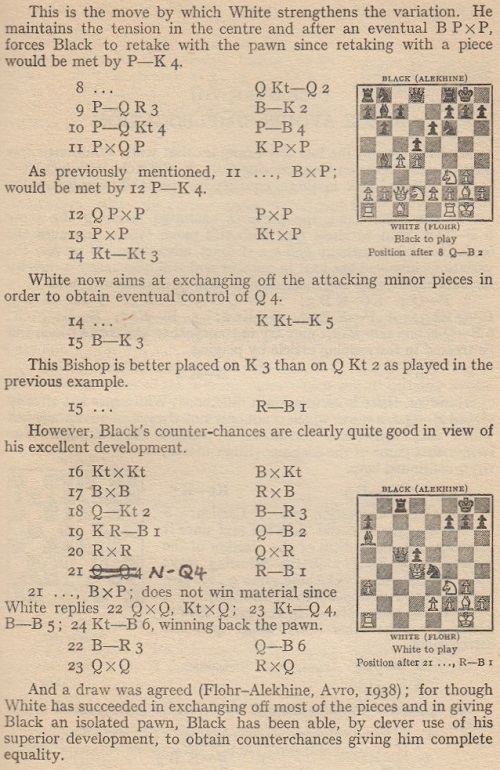
(9797)
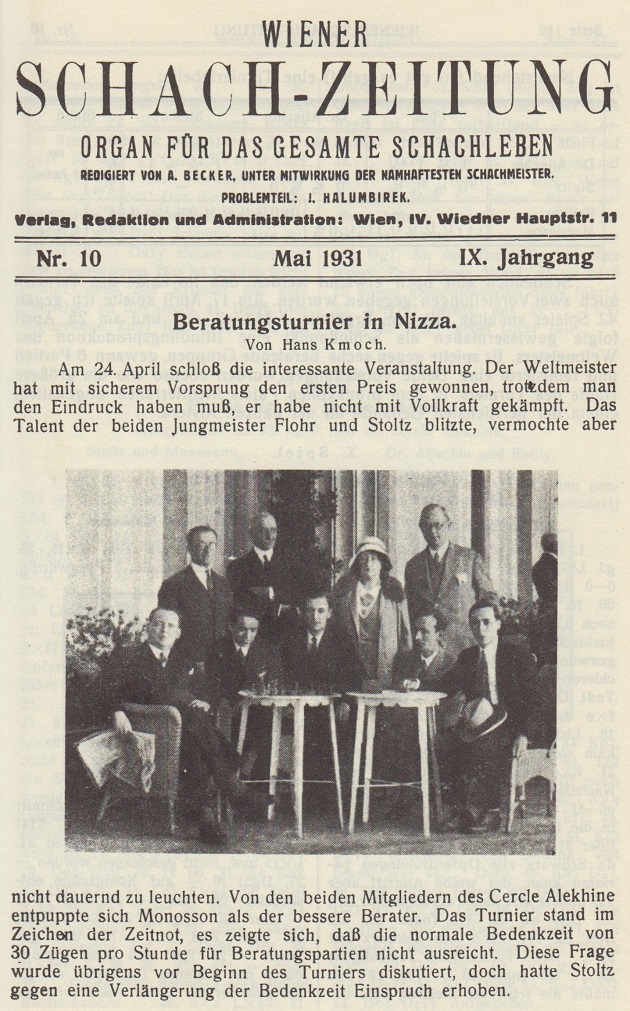
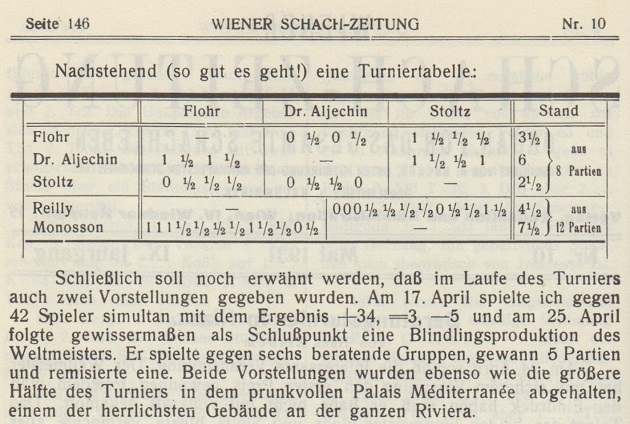
Is it possible to find a better copy of the photograph, with a full caption?
A tournament held in Nice earlier that year was won by Reilly, and a group photograph, which also included Duchamp, Mieses, Noteboom and Znosko-Borovsky, was published on page 201 of the May 1931 BCM. A clearer copy is on page 117 of the March 1981 issue.
(10269)
An observation about Capablanca’s play in the 1930s:
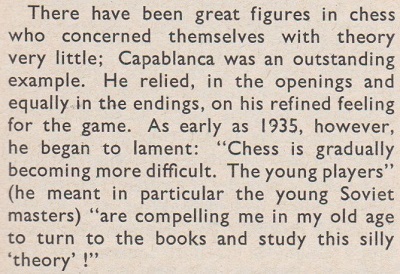
Source: an article entitled ‘Chess Theory is Grey’ by Salo Flohr on pages 157 and 180 of CHESS, March 1967. No information about the article’s provenance was supplied, or about the circumstances of Capablanca’s alleged incipient lamentation.
(11054)
The start of an article entitled ‘Modern Chess Dull?!’ by Fred Reinfeld on page 32 of the Chess Review, March 1940:
‘It is unfortunate, but true, that a sizable proportion of amateurs find modern master chess dull. “Ah, the good old days!” This is based on what is for the most part an imaginary kind of chess which is supposed to have been peculiar to any age but our own. If the good old chess was really so interesting, we should expect it to have flourished in the first International Tournament, held at London in 1851. If we turn to the Book of the Tournament, however, we discover that it is an epochal collection of the most dreary, tedious, witless, planless, slovenly and inept chess that has ever been assembled between the covers of a book. Of the 85 games in the main event, not more than five could be described as brilliant by the most charitable man in the world; and he would be hard put to it to find ten games that were worth looking at.
It is impossible to retain any more illusions about the chess of this period as one reads Staunton’s peppery philippics against his bumble-fingered colleagues. (And since he was much inferior to present-day analysts, he leaves myriads of blunders untouched!)’
Reproducing the article, until the title ‘Ah, The Good Old Days!’, on pages 96-98 of his anthology The Treasury of Chess Lore (New York, 1951), Reinfeld added this introduction:
‘At the time I wrote this article I was nettled by the disparagement of modern masters which flourishes side by side with unthinking praise for the ancients. My views are still the same, although my approach to his [sic] type of controversy has mellowed considerably!’
‘The Good Old Days’ was the heading to game 46 (Flohr v Landau, Antwerp, 1930) on page 91 of Chess Strategy and Tactics by Fred Reinfeld and Irving Chernev (New York, 1933):
‘In every chess era the greybeards are forever bemoaning, maliciously or mournfully, the passing of “the good old days”. Nowadays, for example, one hears that there is no “brilliancy” left in chess, no sacrifices, no combinations. There is nothing left, runs the wail, but stodgy woodshifting. For those who still look back sadly to the flashy and trashy confetti of so-called “immortal games”, we offer a bit of consolation ...’
On page 181 of Great Brilliancy Prize Games of the Chess Masters (New York, 1961) Reinfeld introduced Flohr v Landau as follows:
‘Many years ago, when I first saw this game, it seemed to me an effective refutation of the charge that modern chess is much less brilliant than the old-time variety. Now that so many years have passed, this game is no longer “modern”, but it is still a delight to play over and appreciate.’
1 d4 Nf6 2 c4 c6 3 Nf3 d5 4 e3 e6 5 Nbd2 Be7 6 Bd3 Nbd7 7 O-O O-O 8 b3 c5 9 Bb2 cxd4 10 exd4 dxc4 11 bxc4 b6 12 Qc2 Bb7 13 Ne5 Qc7 14 f4 Rfd8 15 Ndf3 h6 16 Qe2 Nxe5 17 fxe5 Nd7 18 d5 Bc5+ 19 Kh1 exd5
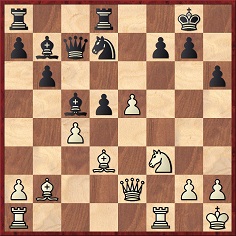
20 Ng5 Nf8 21 Nxf7 Re8 22 Qg4 Re6 23 Bf5 Rae8 24 Bxe6 Rxe6 25 Nd6 Bxd6 26 exd6 Qd7 27 Ba3 Nh7 28 h3 dxc4 29 Qxc4 Nf6 30 Rxf6 gxf6 31 Re1 Bc8 32 Rc1 Bb7 33 Qg4+ Kh8 34 Rc7 Re1+ 35 Kh2 Qxg4 36 hxg4 Resigns.
From page 627 of L’Echiquier, 12 February 1930:
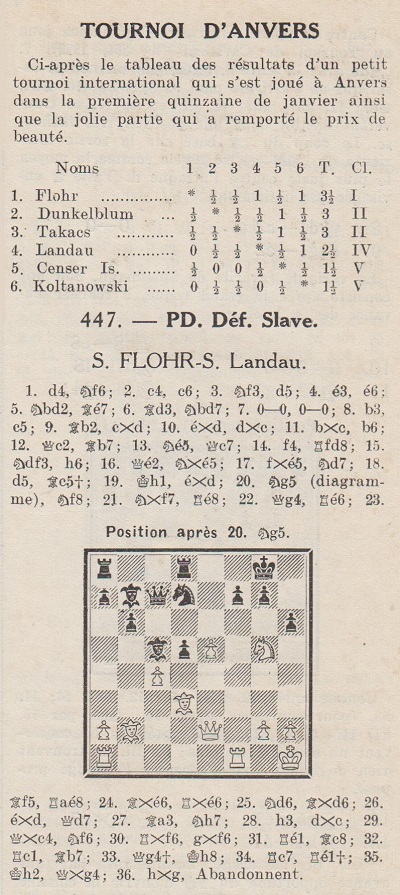
Flohr annotated his victory on pages 46-47 of Československý Šach, March 1930:
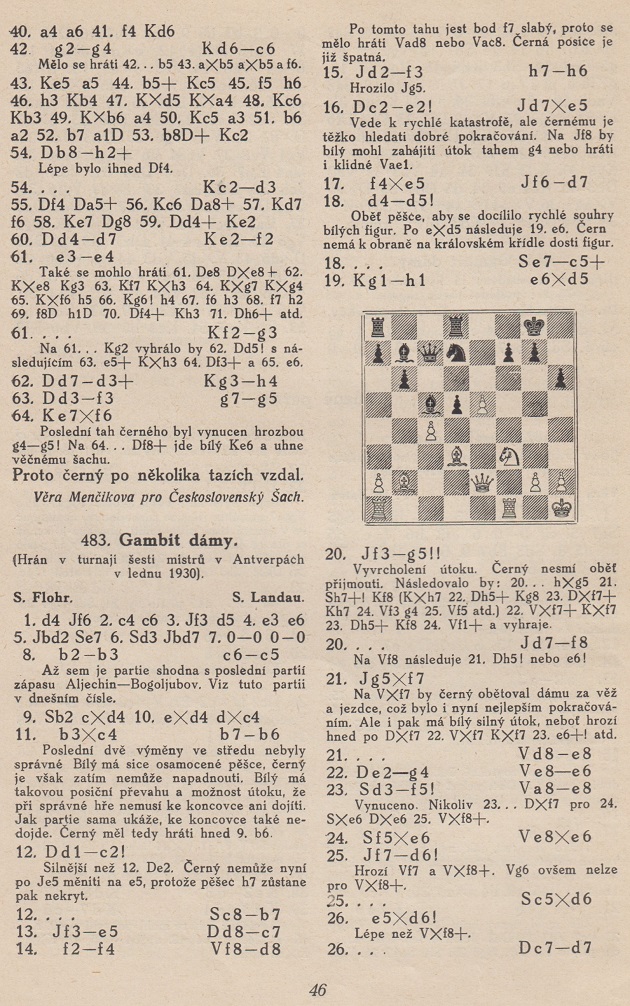

(11176)
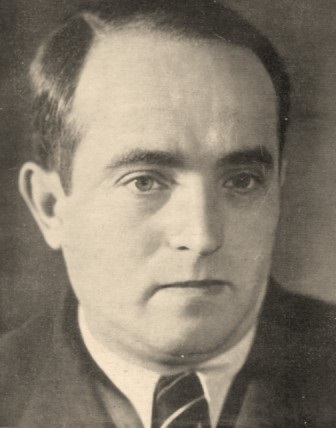
To the Archives
for other feature articles.
Copyright Edward Winter. All rights reserved.